Jose Cuervo is no friend of mine. Not after I’ve seen how (and where) the good stuff is made.
This, my friends, is the story of how tequila is manufactured. It occurs in one place and one place only: Tequila, Mexico. And it all begins with the blue agave plant. That’s what you see in the big photo above.
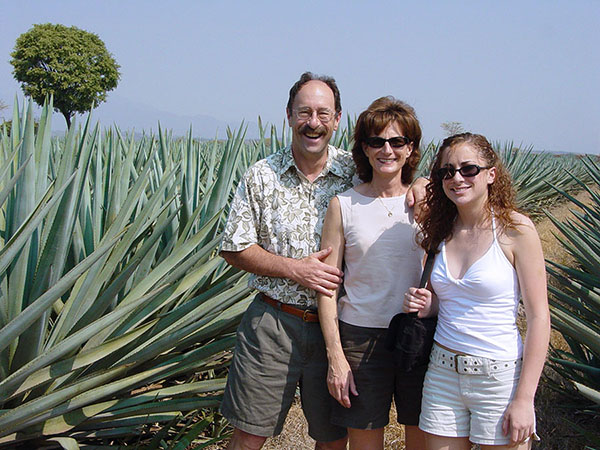
Yes, Tequila actually is a place. It’s about 50 miles northwest of Guadalajara, Mexico.
The origins of this story, for me, go back to the early 1990s, when Baja John and I rode our motorcycles the length of Baja and then took the ferry across the Sea of Cortez to mainland Mexico. John and I stayed in beautiful Guadalajara for a few days on that awesome trip and I fell in love with the place. I was determined to get back there someday, and that someday occurred sooner rather than later. Just prior to a 4-day Memorial Day weekend in 2003, I bought three AeroMexico tickets, and Susie, our daughter Erica, and I explored Guadalajara and the interesting places around it. One of those places was Tequila, with good buddy Carlos as our guide. You’ll see Carlos a photo or two down.
Making tequila starts in the fields with the blue agave harvest. The blue agave is a majestic plant that grows in the red earth of the region, where the soil, water, sunlight, and everything else the tequilameisters worry about is Goldilocks perfect.

The blue agave takes about 8 years to reach maturity, and each one produces about 8 bottles of tequila. As you might imagine, security around these fields is tight.

The guys that harvest the agave plant are the Airborne Rangers of the operation. They chop away the pineapple leaves (the pineapple is the plant’s heart), and they do so with a tool that made me nervous just looking at it. It’s a deal that has a plate-sized blade on the end of a long handle. The operators keep the plates razor sharp (they carry stones and sharpen the blades constantly). The scary part is they hold the pineapple down with one foot and whack at it with that tool, missing their toes by millimeters. The plants are tough, the guys work quickly, and when I asked our guide Carlos about it (that’s Carlos in the photo above), he told me accidents are not unheard of out in these fields. Think about that the next time you sip a good tequila.

Here’s the agave field after it has been harvested.
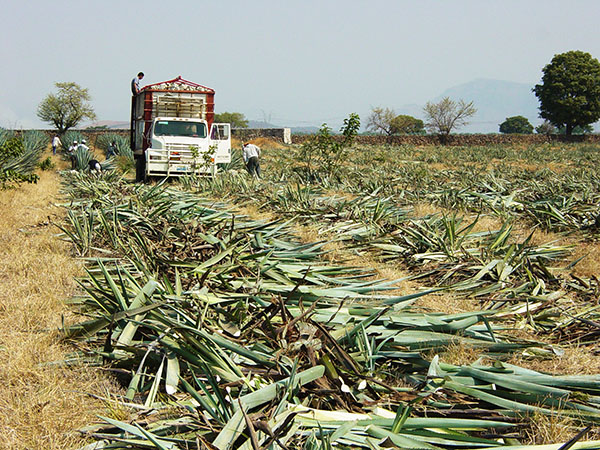
The pineapples weigh between 80 and 120 pounds, so the guys doing this get a workout all day long. I imagine the truck you see below was resting on its axles after it had been fully loaded. I’ll bet those guys sleep well at night.
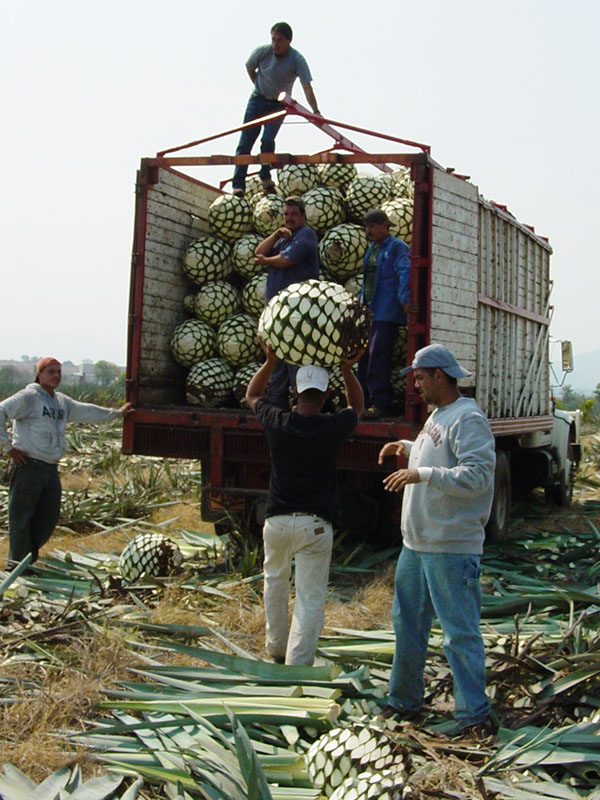
The pineapples are then transported to the factory to be turned into tequila. The process goes like this: Bake, squeeze, ferment, distill (a little or a lot), age (a little or a lot), bottle, label, and drink (a little or a lot).
But I’m getting ahead of myself. Let’s throttle back a bit to see what it all looks like.
Caldera is Spanish for boiler, and the heat and steam produced by the boilers is needed for the slow agave pineapple bake. Hang in there; this is about to get very interesting.
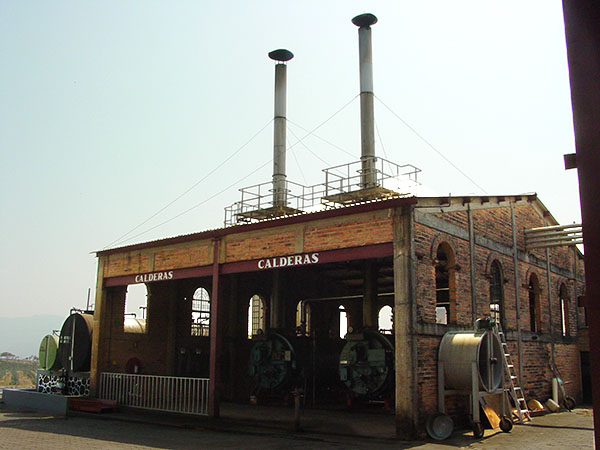
The tequila pineapples are delivered to the hornos in the factory. Horno is Spanish for oven. It’s where all that heat and steam from the calderas gets put to good use.
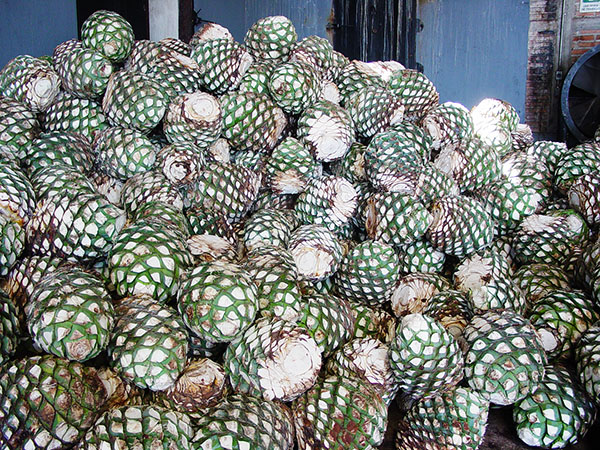
The hornos are room-sized brick ovens that are stacked full of the harvested agave pineapples. Think of them as immense crock pots.
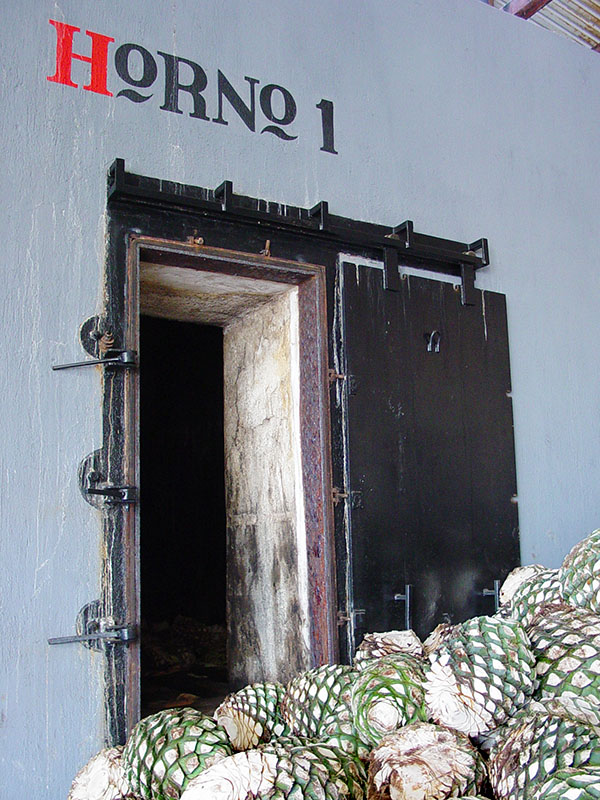
After an all-day bake, the pineapples are soft and mushy. Carlos peeled off a piece for us and we tasted it. The plant had a sweet and faint tequila flavor, but it contained no alcohol yet. It would make for a good candy, but the plants are too valuable for that. There’s more money in turning them into tequila.
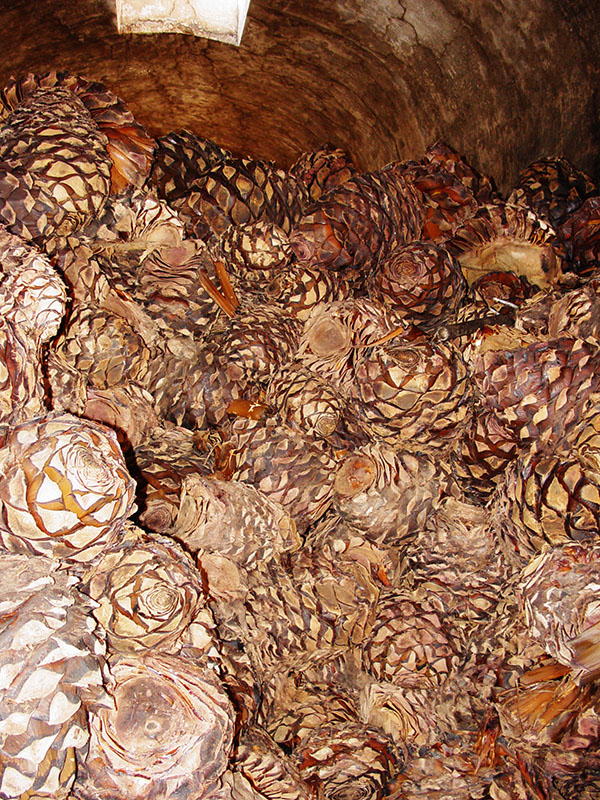
The baked blue agave hearts then go through crushers, which separate the juice from the pulp.
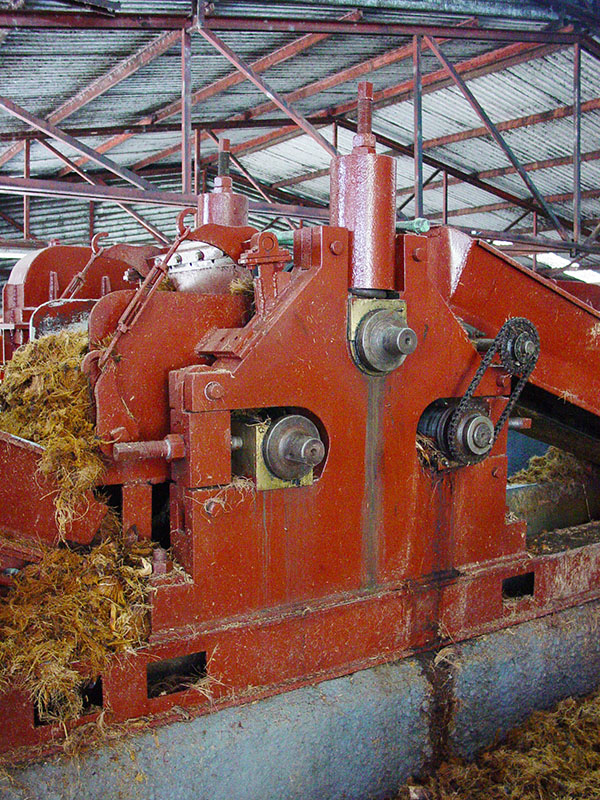
The juice goes on to giant vats (we’ll see those in a second) and the pulp is sold separately as an agricultural byproduct. Farms use it for feed (lucky cows, I guess) or compost.
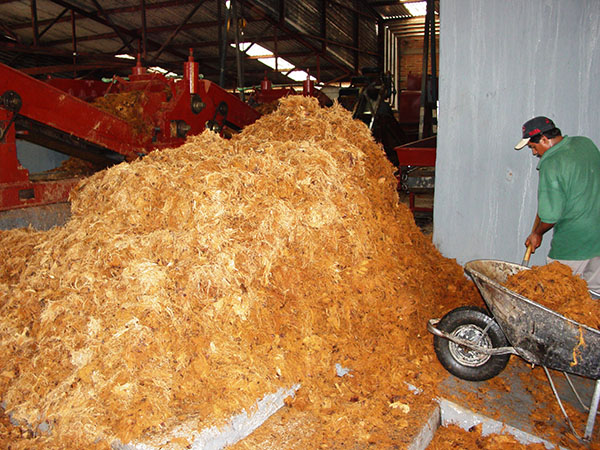
The vats shown below are where the agave juice ferments for 2 to 5 days. That’s where it develops its initial alcohol content. Carlos explained that it is basically a tequila-based beer at this point. When the Spaniards arrived in the New World, they found the native Mexicans making and drinking this. The Spaniard’s contribution to the development of tequila was the distillation process, and that’s what takes this gift of the gods from agave beer to tequila.

I noticed that some of the vats were bubbling, and I asked Carlos if there were air injectors or heaters in the vats. Nope, that bubbling occurs naturally as a consequence of the fermentation process.
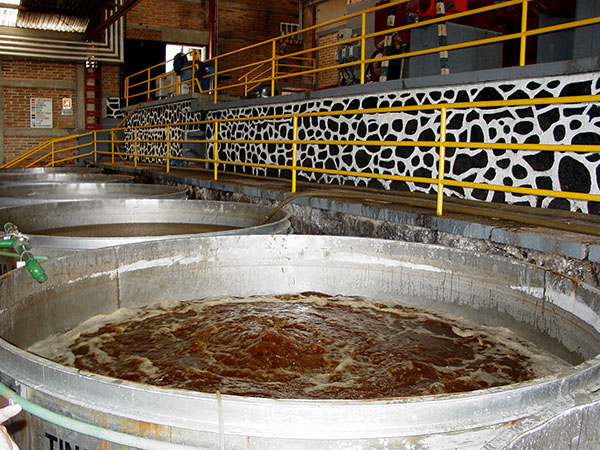
The factory helps the process by planting fruit trees that attract a certain kind of insect around the fermentation building. The bugs are drawn to the scent of the fermenting tequila juice. They fly into the vats and drown, and their decomposition accelerates the fermentation. It’s a good thing I developed a taste for tequila before I knew that.
The photo below shows the distillation line.
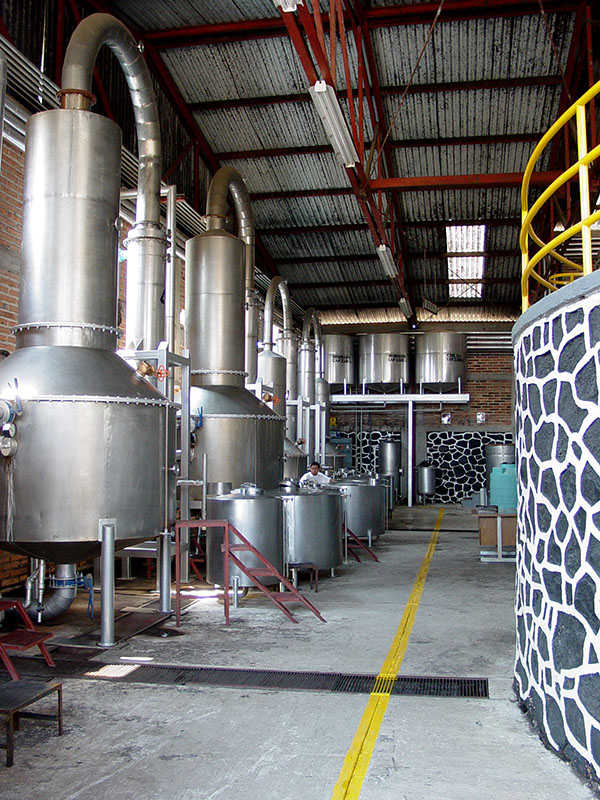
Distillation is followed by aging in oak barrels, and how that’s done is a big part of what makes for different grades of tequila.
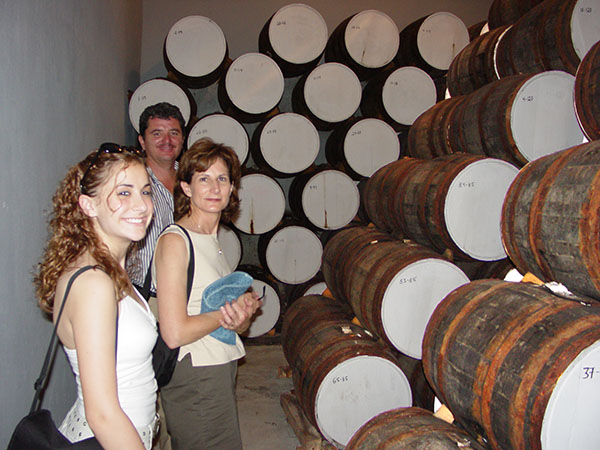
The pecking order for different tequila grades goes something like this:
-
- Cheap tequila is produced from the juice of the agave plant mixed with other juices. You can get a pretty nasty hangover from this kind of tequila (like I said at the beginning of the this blog, Jose Cuervo is no friend of mine).
- The next big step up is tequila made of 100% blue agave juice. If it’s that kind of tequila, there will be a notation somewhere on the label that says 100% agave. If it doesn’t have that, it’s the cheap stuff, not matter what some smooth-talking liquor store dude tries to tell you. 100% blue agave tequila is less likely to give you a hangover, too.
- Higher grade tequilas are aged in oak barrels, and the amount of time they are aged makes for a better grade of tequila. Longer is better.
- Really good tequila is distilled multiple times and aged.
- Really, really good tequila is aged for 2 years in French oak barrels. This kind of tequila has a dark brown appearance, and when you turn it in the light, it looks like it contains little flecks of gold (it doesn’t actually have flecks of anything in it, but it looks like little pieces of gold). This tequila can go for hundreds of dollars a bottle.
After distillation (and after aging, if you’re going for the good stuff), the next step is bottling. Then the bottles are labeled, and then they’re packaged.


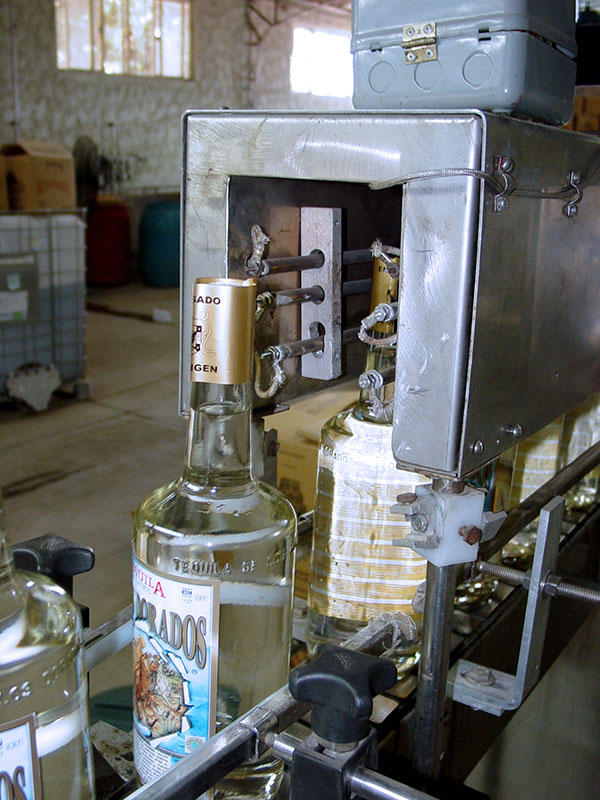
Our tour was at the La Cofradia distillery in Tequila, about an hour northwest of downtown Guadalajara. Surprisingly, the La Cofradia distillery had a tasting room (just like you’d see at a vineyard), and we sampled different tequilas after the tour. The bottle that our guide, Carlos, is holding in the photo below is the good stuff with the dark brown color and gold flecks. I tried a sip, and it was very, very smooth indeed. I was tempted, but I wasn’t going to drop $400 (in 2003, or for that matter, at any other time) on a bottle of tequila.

Just for giggles, I Googled “expensive tequilas” and I found that you can pretty much go crazy spending money on tequila, including one that sells for $6700. I’m not into it like that. I’ve found that the best place to buy reasonably-priced 100% blue agave tequila is Costco.
I am glad we visited Guadalajara and Tequila when we did. With the pandemic and the drug cartel situation down there, I don’t know if I would do it again today. I looked up Guadalajara safety and it’s rated as a medium risk city. By today’s standards, that’s probably accurate. Truth be told, I’d much rather visit Guadalajara than, say, Portland, Chicago, or Seattle these days. The pandemic will pass; the drug situation in Mexico will take longer. I hope the Mexican government gets on top of it soon. I’d like to explore mainland Mexico again.
If you’re planning a ride into Mexico, make sure you insure with the best and our favorite: BajaBound!
 Want to know more about riding in Baja? Just click here.
Want to know more about riding in Baja? Just click here.
If you enjoyed reading about how tequila is produced, you might enjoy our story on Jack Daniel’s, too.


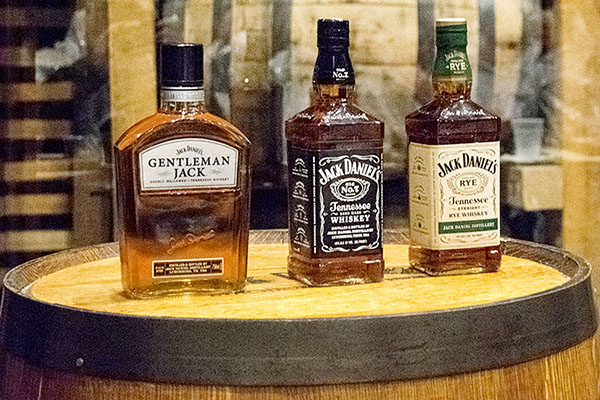
Thanks, Joe, for another great write-up. Just wanted to let your readers know that I recently visited Tequila and Guadadalara (now in EDOMEX) by motorcycle and saw no reason for being reluctant to travel the country. Use of hand sanitizers and masks is widespread as the infection rate is dropping. We toured La Riendas distillery and had a great time.
¡Saludos!
That’s awesome, and thanks for the input!
Regardless of the subject, this story is one of the very best examples of journalism I’ve ever seen!
It has a beginning, a middle and an end all glued together with personalized interesting asides!
Great job …… it also transferred valuable information…. buying more Costco stock!
Carl M. Aka Carlos
Muchas gracia, Carlos! Nuestro mejor para Maria!
Great article. Unfortunately I have to avoid Tequilia. As the Tequilia goes down strange things happen. BTW – You always have great models to enhance the story.
Thanks, Mike.
One evening on one of the RX3 Baja trips I was privileged to participate in a seminar on the finer points of tequila, presented by J. This was in Guerrero Negro IIRC
I learned that there was the cheap stuff that was only consumable by doing “shooters”. I knew about that stuff from my younger days, and the regrets the next morning. But J waxed poetic about “sipping” tequila, the good stuff, and the better and the best stuff. He said that it was to be sipped, that shooting or mixing it (margaritas) was a waste of good tequila. Silver is good, gold is better, and reposad0 is the best, providing you choose a reputable brand. I sipped a lot of silver, of a good brand,that night, more than I should have, but suffered no ill effects in the morning.
On a later motorcycle trip I had the privilege sampling both silver and reposado of the same brand. The reposado was smoother but I actually preferred the silver — I felt that it had more character.
I remember that trip. Good times, even without the tequila.
Great write up on real Tequila ( or should I say bug juice). Don’t drink it much anymore but do remember the hangovers from the cheap stuff…..Costco you say….. 😉
Costco is your friend. If they only sold guns and ammo…